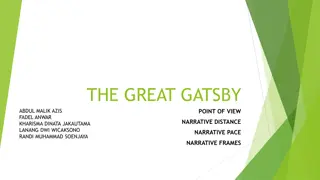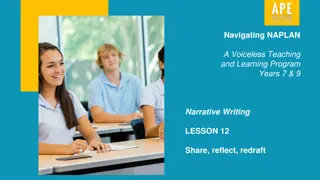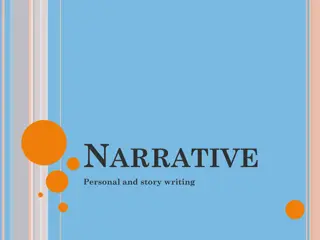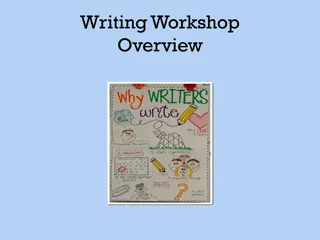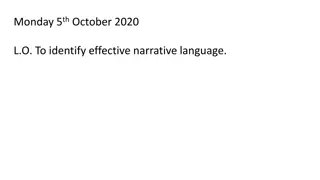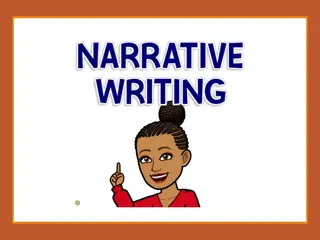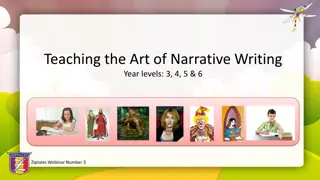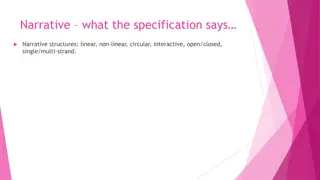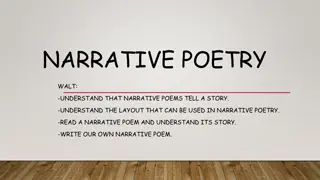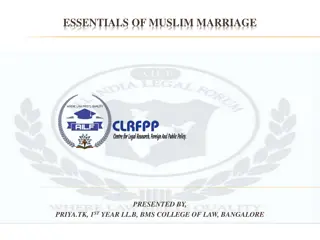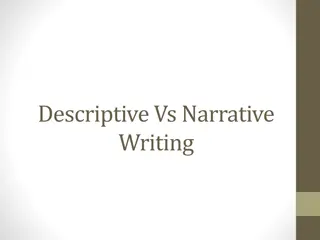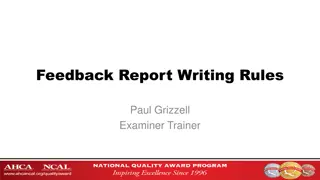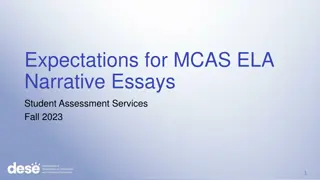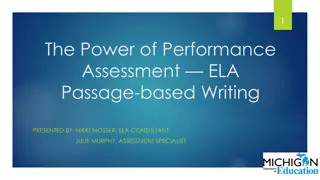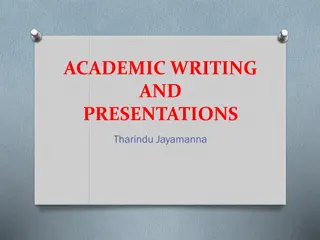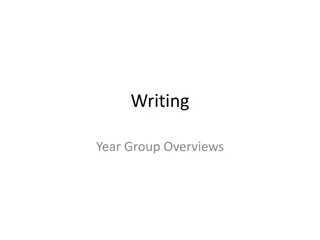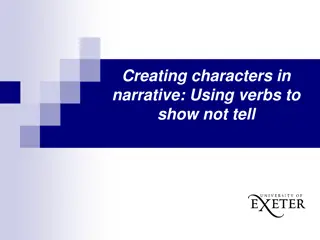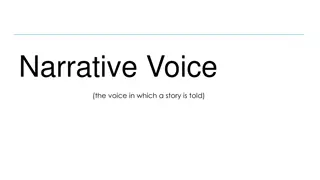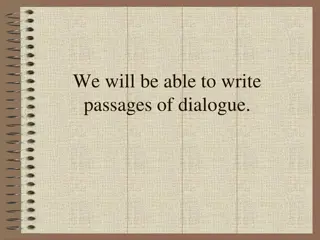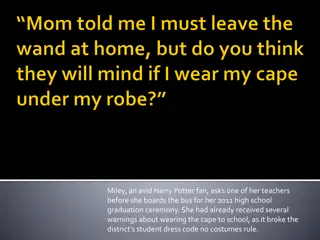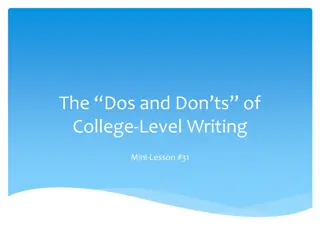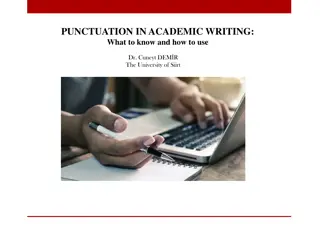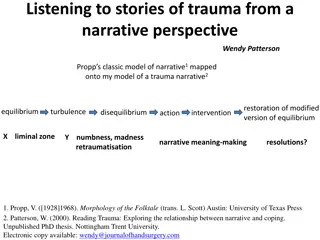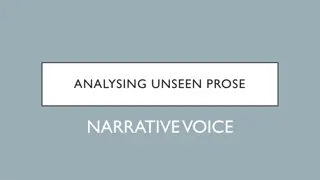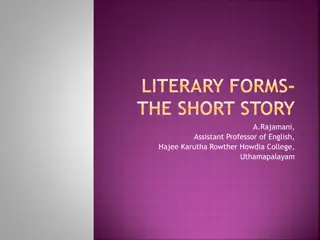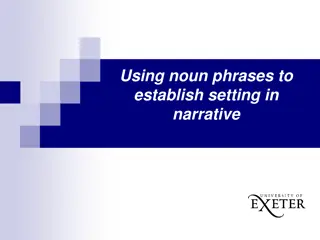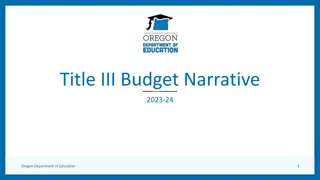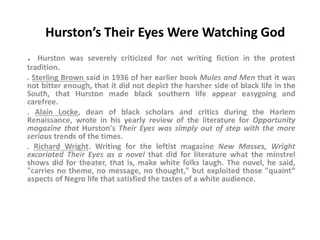Narrative Writing Essentials
Explore the fundamentals of narrative writing, including definitions of key terms like melancholy, personification, and analepsis. Dive into vocabulary challenges and writing strategies for crafting effective narratives.
Download Presentation

Please find below an Image/Link to download the presentation.
The content on the website is provided AS IS for your information and personal use only. It may not be sold, licensed, or shared on other websites without obtaining consent from the author. Download presentation by click this link. If you encounter any issues during the download, it is possible that the publisher has removed the file from their server.
E N D
Presentation Transcript
Planner Please have your planner open on today s date Date: Saturday, September 14, 2024 Narrative Writing Copy 1) What is narrative writing? Do 2) What does the adjective melancholy mean? 3) Explain what personification is. 4) What is analepsis? 5) merciless iced east winds is from which poem?
Learning Focus: To plan and produce a narrative response to a video. Learning Outcomes: Understand what makes an effective narrative. Plan and respond to a video and include the non-negotiable writing strategy.
mesmerising boundless sublime intrepid nonchalant melancholy Vocabulary Challenge: What do these words mean? Are there any you need to look up and log?
Paper 1 Writing Section B Question 5 AQA say: Students are required to write a creative response linked to the topic or theme of the Source in Section A. They have the opportunity to demonstrate their narrative or descriptive writing skills in response to a written prompt or a visual image. The question will give a choice of a descriptive and a narrative task, two descriptive or two narrative tasks. We accept that it is likely that descriptive pieces could well include elements of narrative, and narrative is very likely to include elements of descriptive writing but the main focus should be descriptive for descriptive writing and narrative for narrative writing. The statement that precedes Q5 on Paper 1 tells students the audience and purpose of the writing. Students will be credited for their writing in terms of content and organisation (AO5) and technical accuracy (AO6). A useful skill for students will be to craft their work and leave an appropriate amount of time to check and review their work.
narrative noun noun: narrative; plural noun: narratives 1. a spoken or written account of connected events; a story. "a gripping narrative" synonyms: account, story, tale, chronicle, history, description, record, portrayal, sketch, portrait, statement, report, rehearsal, recital, rendering
Narrative Top Tips 1.Circular narrative: One sentence, a phrase, a word, one-word paragraph which begins and ends in the same location. The narrative must be no longer than 5 minutes in real-time. 2. Introduce the main character using Show not Tell. Focus on face, body language, gait and build in Tell- show 3 (;) 3. Motif: Hands, coat, phone, footsteps, clock, photograph repeated several times in the narrative. 4. flash-back/ memory/ flash-forward. 5. Write in the 3rd person as a detached observer, almost like a fly-on-the-wall. 6. A description of the weather/ setting using figurative language. Tip: Further on in the narrative have the weather suddenly switch to a more ominous description. 7. Build in Poetry references and key words to enrich vocabulary. For example: bombarded, intoxicated, incessantly, impassively, exploding comfortably , strung out like bunting .
Step One Let s discuss your interpretations As a class, we are going to watch this clip. Write down things you deem as interesting as we watch it. Where is the individual going? What is the atmosphere like? Who is the person? How does he or she feel? Where are they going? Class Ideas https://www.youtube.com/watch?v=BO a0zQBRs_M
Step Two Establishing Character Who is your character? Where are they going? How do they feel? Where have they been? SHOW not TELL Think about what is happening in the news, could you use information from that? Class Ideas https://www.youtube.com/watch?v=BO a0zQBRs_M
Step Three - Motif What is a motif? Thinking back to the video. What could be your motif? Let s discuss your ideas Class Ideas
Step Four - Flashback Thinking back to the video. Why is a flashback effective? How would it help you reach top band answers? How can you ensure your flashback is effective? Class Ideas Is your character going to experience a positive flash back? Are they thinking back to their family life and home? Are they thinking about how far they have come? Let s discuss your ideas
Step Five - Weather Techniques? Could this be the turning point? Is the weather going to become sunny? You could use your flashback to describe the weather. What vocabulary and techniques could you use from the conflict poems? Class Ideas
The tell: show 3 rule is a way to ensure you use colons and semi colons correctly. For example: She sat quietly: hands on her lap; mouth dry; mind racing. Then, list 3 things which show how the character is feeling. Use semi-colons to break up the list. First, tell the reader what your character is doing and follow it with a colon.
Narrative journey plan (5 minute real-time frame) Figurative language Motif? Uncertainty and desolation surrounded the woman. Link back to the beginning -Focus on tell show three rule she was trapped: trapped in her thoughts; trapped in her atmosphere; will she ever be freed? Rain Tears? FLASHBACK -Focus on the weather -Rain intensifies -Use pathetic fallacy menacing rain merciless winds Circular narrative Circular narrative Power & Conflict references x3 Bombarded Pummels Colossal wreck
Uncertainty. She stared down the menacing streets that surrounded her she was trapped: trapped in her thoughts; trapped in her atmosphere; will she ever be freed? She inhaled deeply, sucking in the life she so desperately wanted; another chance to start again. Darting through the pounding rain, tears pumped from her eyes, as the unforgiving rain pummelled the streets below. What techniques has this individual used? Are they effective? How could this be improved? Can you spot any language techniques? Drip. Drip. Drip. She ran, it made her forget all of her problems. She nuzzled her neck in to her jacket, which provided very little protection from the merciless winds. Hands gripped tight around the umbrella, like it was her only life line, her only hope. The menacing rain continued to attack her as she twisted and turned through people to get to safety. Something in her stomach jolted. She was not alone. She turned around to see a man with a piercingly peculiar face glaring at her. She knew who he was and why he was following her, but still she convinced herself that she had never seen him before in her. A wave of anxiety engulfed her.
Write up Verbs to describe the effect of weather: engulf: (of a natural force) sweep over (something) so as to surround or cover it completely. mask: conceal (something) from view. blanket: cover completely with a thick layer of something. conceal: to hide from sight. Leg 2: Introduce your motif, establish character, show not tell. Leg 3: Flashback Weather Success Criteria: Begin in media res Subtle hints about future plot events Language appropriate to character Show not tell High punctuation integrated throughout (minimum colon and semi colon) Rules: 15 minutes per leg. We will go through and read some out afterwards. Remember, there is no set structure but if you follow the steps you will have all the elements you need for a top band answer. Leg 4: Circular narrative, linking back to the beginning. Leg 1: Establishing setting Poetry as inspiration Are there any quotations / techniques we could use in creative writing?



